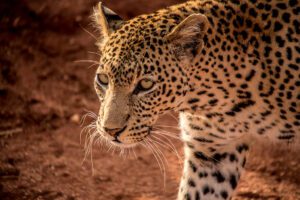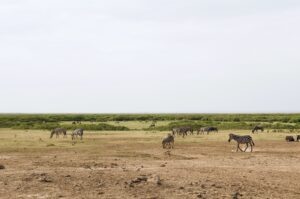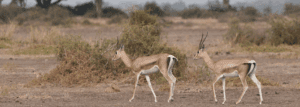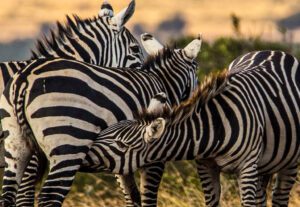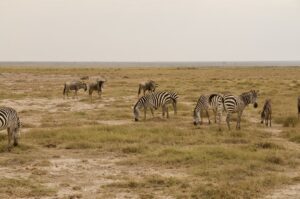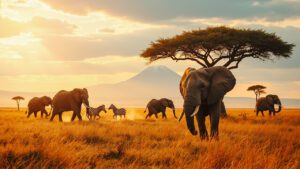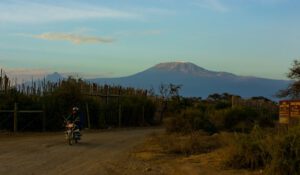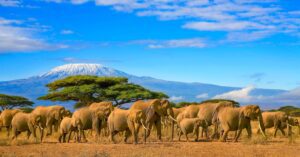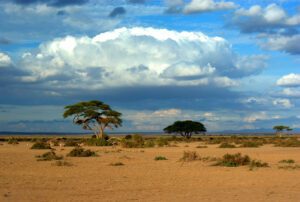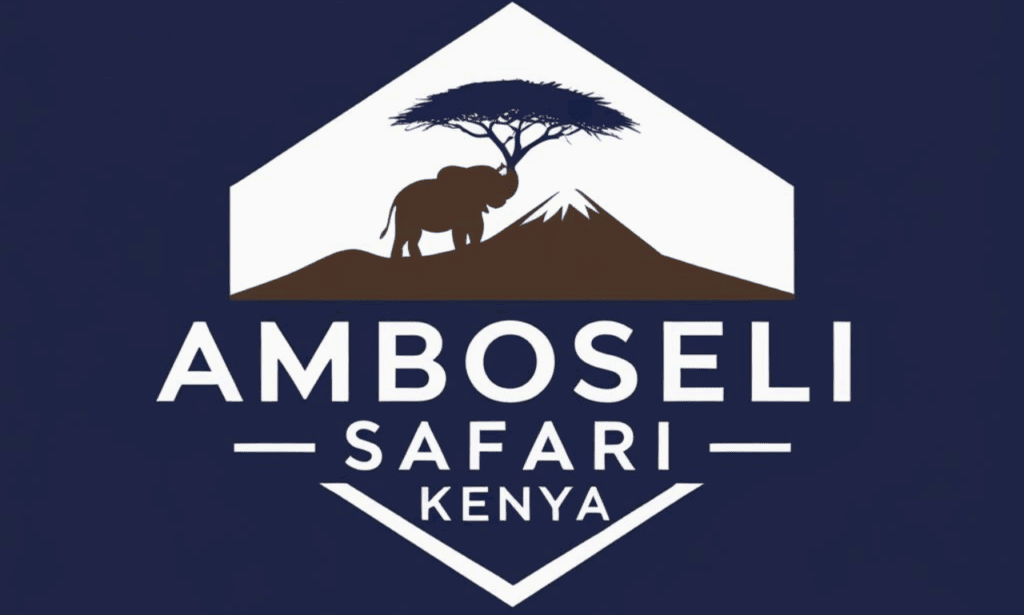Imagine stepping into a real-life version of The Lion King, where the animals aren’t just on a screen, they’re right there with you! That’s what a walking safari in Amboseli is all about. Unlike a traditional safari where you ride in a vehicle, this adventure lets you explore the wild beauty of Kenya on foot, surrounded by incredible landscapes and wildlife. It’s like taking a walk through nature’s most fascinating classroom, with Mount Kilimanjaro towering in the background. But don’t worry, it’s all safe, guided, and insanely cool! Curious about how it works or what you’ll see? Let’s break it down, step by step.
What is a walking safari, and how does it differ from a traditional safari?
A walking safari is an outdoor experience where you explore the natural environment on foot, accompanied by an experienced guide and often a ranger. Unlike a traditional safari, where you ride in a vehicle to observe wildlife from a distance, a walking safari immerses you in the wild. This unique safari adventure allows you to experience nature up close, observe animals’ habitats, and notice smaller details like insects or plants, making it a great trip for those seeking a special wilderness experience.
The key difference is the scale and intimacy of the experience. In a traditional safari vehicle, you cover larger areas quickly and focus primarily on iconic animals like lions, elephants, or giraffes. However, during a walking safari, the focus shifts, it’s not just about spotting “big game” but about slowing down, using all your senses, and connecting with the landscape. For example, instead of zooming past a termite mound in a car, on foot, you’d learn how termites build their homes or how predators interact with these structures, enhancing your understanding of the diverse wildlife species.
Walking safaris also provide a quieter, more thrilling experience since you’re at ground level in the animals’ world. While vehicles allow protection from predators, walking safaris rely on guides who understand animal behavior, ensuring safety. It’s not just about animals, though, you’ll notice things you wouldn’t from a car, like the scent of wildflowers, the sound of cracking branches, or the tracks animals leave behind, creating unforgettable safari moments.
While traditional safaris are great if you want to see many animals quickly and from a safe distance, walking safaris offer a slower, deeper connection to the wild. It’s like the difference between watching a wildlife documentary and stepping into it yourself, walking safaris make you feel like a part of the ecosystem, not just an observer, providing a truly immersive experience in popular wildlife destinations like the Maasai Mara or Botswana.
Where is Amboseli located, and why is it famous for walking safaris?
Amboseli is located in southern Kenya, near the border with Tanzania. Its full name is Amboseli National Park, and it is one of the most popular wildlife destinations in Kenya. The park is known for breathtaking views of Mount Kilimanjaro, Africa’s tallest mountain, which towers just across the border in Tanzania. This iconic backdrop, combined with a rich variety of wildlife species, makes Amboseli a must-visit for safari enthusiasts seeking unforgettable safari experiences.
Renowned for its open landscapes, vast swamps, and dry plains, Amboseli is an excellent location for walking safaris. Visitors can explore certain areas on foot with the guidance of rangers and professional Maasai guides instead of spending the entire time in a vehicle. These intimate nature walks in Amboseli allow you to observe both the “big” game, the elephants, lions, and giraffes the park is famous for, and the smaller but fascinating details of its environment, like unique plant species or animal tracks.
What sets Amboseli apart is its elephant population. It is one of the best places in Africa to see elephants up close, and during a walking safari, you might have the chance to observe herds (from a safe distance, of course!) and learn about their behavior, communication, and matriarchal structure. Walking safaris in Amboseli also allow you to explore the region’s rich cultural history, as the Maasai people, an Indigenous community, have lived here for generations, deeply intertwining their traditions with the land.
Thanks to Amboseli’s relatively flat terrain and outstanding visibility, it’s a perfect location for walking safaris, as guides can spot wildlife from far away to avoid surprises. Combining breathtaking landscapes, diverse ecosystems, and the chance to engage with local culture, walking safaris in Amboseli offer an unparalleled safari adventure.
What wildlife can be expected to see during a walking safari in Amboseli?
On a walking safari in Amboseli, expect to see an array of animals, plants, and landscapes up close. While the exact sightings depend on luck, time of year, and the area you’re exploring, Amboseli’s reputation as a popular wildlife destination ensures that there’s always something extraordinary to observe. This makes it one of the best safari places for those seeking a unique adventure.
Amboseli is most famous for its elephants, so they are a highlight of any safari, on foot or otherwise. The park is home to some of Africa’s largest herds of elephants, and they are often calm enough for you to watch them from a safe distance. Observing these majestic animals walking slowly through the grass, socializing, or drinking from waterholes can be a surreal, almost spiritual experience, making for unforgettable safari moments.
In addition to elephants, walking safaris often reveal more subtle creatures that you might miss on a traditional safari. For example, you might come across giraffes grazing on acacia trees, zebras trotting through the plains, or gazelles nervously scanning the horizon for predators. Warthogs, wildebeests, and buffalo are also common sights. If you’re lucky, you might spot predators like lions or cheetahs, although guides ensure any interactions with such animals are handled with extreme caution and from a distance.
Beyond the big game, walking safaris bring attention to smaller details of the ecosystem, like brightly colored birds such as lilac-breasted rollers, kingfishers, or weaver birds creating intricate nests. You also learn to identify animal tracks, dung, or scratch marks, which tell stories about what animals were in the area before you arrived.
Amboseli’s swamps provide a unique setting for waterbirds like flamingos or herons, and you’ll also notice how animals rely on this water source during the dry season. Walking safaris make you feel like a detective piecing together the puzzle of how all life in this ecosystem connects, creating a special wilderness experience that is hard to forget.
Are walking safaris in Amboseli safe, and what precautions are taken?
Walking safaris in Amboseli are generally safe, but they require careful planning and strict safety precautions. Unlike traditional safaris, which typically involve staying in the safety of vehicles, walking safaris bring you closer to nature, which can feel thrilling but also involves risks. To make them safe, a lot of preparation goes into ensuring visitors are protected during their safari adventure.
First, walking safaris are always led by highly trained professional guides and armed rangers. These individuals are experts in tracking animals and understanding their behaviors, ensuring a great trip for every tourist. For example, guides know how to read warning signs from animals, like when elephants flap their ears or lions growl. This expertise helps ensure you avoid surprising or startling wildlife.
Safety precautions also include sticking to specific walking routes and times. Most safaris happen in the early morning or late afternoon when animals are more active and visibility is good. Guests are provided with safety briefings before the walk begins. For instance, you are told to stay quiet, keep close to the group, avoid sudden movements, and never run if you encounter a wild animal.
Additionally, guests are typically advised to wear neutral-colored clothing, such as khaki or beige, so they blend in with the surroundings and avoid attracting attention from animals. Guides also carry communication equipment, such as radios or satellite phones, in case of emergencies during these intimate nature walks.
To put it simply, walking safaris in Amboseli are safe as long as everyone follows the rules, listens to their guide, and respects the environment. It’s all about blending into the natural world and being aware, rather than interfering. So, while there is an element of adventure, it is carefully managed to prioritize your safety.
What is the best time of year to go on a walking safari in Amboseli?
The best time for walking safaris in Amboseli is during the dry seasons, which usually fall between June and October and then again from January to March. The dry seasons provide ideal weather conditions and make spotting wildlife much easier compared to the wet seasons.
During these months, the landscape is more open because grass and vegetation are shorter. This improves visibility, allowing you to see animals from a safe distance. For example, if you’re on foot, you’ll be able to spot grazing elephants, zebras, or giraffes well before getting too close. The dry season also means animals gather around water sources like Amboseli’s famous swamps or watering holes, making it easier to see a variety of animals in one area.
In contrast, the rainy season (November to December and April to May) can make walking safaris more challenging. The rains lead to lush vegetation, which, while beautiful, can make it harder to spot animals. Additionally, wet and muddy trails can make walking difficult or even dangerous. Sometimes, certain walking routes may be closed altogether due to flooding or poor conditions.
Additionally, the dry season has cooler mornings and evenings, which are perfect for long walks without overheating. However, temperatures can get warmer as the day progresses, so morning safaris are particularly popular.
Choosing the right time of year enhances your walking safari experience because you’ll be more comfortable, you’ll see more wildlife, and you’ll be navigating an environment that’s safer and easier to explore. If you’re planning a trip to Amboseli, booking during the dry season will give you the best and most rewarding experience.
How long do walking safaris in Amboseli typically last?
Walking safaris in Amboseli typically last anywhere from two to four hours, depending on the group, route, and specific goals of the safari. These walks are usually designed to balance adventure with comfort since exploring the African wilderness on foot can be physically demanding.
The duration of the safari can vary based on what you’re hoping to experience. For example, a typical morning safari might last about three hours and include breaks for observing wildlife, taking photographs, or appreciating the surrounding landscapes. Guides also use this time to share insight about the flora, animals, and even footprints they come across, turning the walk into an interactive learning experience.
In some cases, shorter walking safaris lasting about two hours may be planned, especially for beginners or those with limited physical stamina. These shorter walks focus on exploring nearby areas around lodges or camps while still offering opportunities to see animals like antelope, zebras, or birds.
Longer walking safaris, lasting three to four hours, are ideal for those looking for a more immersive experience. These safaris might explore more remote areas of Amboseli and provide opportunities for seeing unique vegetation, studying animal behavior closely, and enjoying breathtaking views of Mount Kilimanjaro in the background. However, due to the midday heat, walking safaris rarely extend into the afternoon.
To sum it up, the typical duration is around two to four hours depending on how adventurous and experienced the group is. The goal of these safaris is to make the most of walking in the wild while ensuring participants remain comfortable and engaged.
Do you need a guide for walking safaris in Amboseli, and what role do they play?
Yes, you absolutely need a guide for walking safaris in Amboseli. A guide is not just a companion; they are essential for your safety, experience, and understanding of the environment. Amboseli is a wild area filled with large animals like elephants, lions, and buffalo, as well as delicate ecosystems that require careful navigation. Without a guide, you might unknowingly put yourself in danger or disturb the environment while enjoying your safari adventure.
The guide’s main role is to ensure your safety. They are trained in wildlife behavior and can read the animals’ body language to know whether they are calm or agitated. For example, if a herd of elephants is nearby, the guide will know how to keep a safe distance and avoid provoking them. Guides also carry tools like radios or sometimes weapons to protect against very rare, but possible, dangerous encounters during your trip.
Beyond safety, guides make the experience far richer. They possess deep knowledge about the flora, fauna, and culture of the area. For instance, if you see a footprint in the mud, a guide can explain whether it belongs to a lion, a zebra, or even something rare, like a wild dog. They can also point out smaller but fascinating things you might miss, like animal tracks, bird calls, or plants used in local medicine, enhancing your wildlife viewing experience.
Finally, guides often serve as cultural interpreters. Many walking safari guides are locals who can share stories about the Maasai people, their traditions, and their connection to the land. This makes the safari not just a nature walk, but a deeper exploration of Amboseli’s culture and heritage. In short, guides are indispensable for a safe, informative, and meaningful walking safari.
What fitness level or physical condition is required for a walking safari?
You don’t need to be a super athlete to go on a walking safari in Amboseli, but being in decent physical shape is essential for enjoying this safari adventure. Most walking safaris involve walking for about two to four hours at a relaxed pace, allowing you to soak in the stunning scenery. The terrain is generally flat, but uneven ground, soft sand, or patches of tall grass can make it a bit more physically demanding than a casual stroll in the park. This immersive experience is perfect for those looking to connect with the wildlife species in their natural habitat.
The most important thing is to be comfortable walking for long distances. If you exercise regularly, take brisk walks, or even hike from time to time, you should be fine. However, if you’re not accustomed to long walks, it’s wise to prepare a bit before your trip by taking regular walks or short hikes to build your stamina. Remember, the local Maasai guide will adjust the pace to suit the group, ensuring you won’t be pushed too hard.
If you have health conditions like joint problems, asthma, or heart issues, it’s important to discuss this with your tour operator before booking. Walking safaris can usually be adapted for people with some physical limitations, but it’s better to communicate your needs upfront. For instance, the walking route might be shorter or less intense if someone in the group needs it.
Hydration and proper footwear are key to making the experience enjoyable. Wear comfortable, supportive shoes (like hiking boots) and drink plenty of water. Lastly, walking safaris focus less on speed and more on observing nature, so don’t feel pressured to rush. It’s more important to be curious and engaged than merely physically fit. Just prepare to walk and take in the sights, sounds, and smells of the wilderness!
What cultural experiences can be included on a walking safari in Amboseli?
A walking safari in Amboseli is not just about observing the incredible wildlife; it’s also a perfect opportunity to connect with the rich culture of the Maasai people, who are the original inhabitants of this area. Many walking safaris include cultural experiences that help visitors understand the deep connection between the Maasai community, the land, and the animals, making it one of the best safari experiences available.
One common cultural activity is visiting a Maasai village, known as a “boma.” Here, you can meet Maasai people and learn about their daily lives, customs, and traditions. You might see how they build their houses using local materials like mud and grass, or watch them perform traditional dances and songs. For example, one of their signature dances involves jumping high into the air, a skill Maasai warriors are famous for.
On some walking safaris, expert Maasai guides will join you. These guides can tell you about their knowledge of the land, how they track animals, and how they have coexisted peacefully with wildlife for generations. They may show you how certain plants are used for medicine, food, or even as toothbrushes! Having a Maasai guide on your safari makes the experience much richer because they’ll share stories and perspectives you wouldn’t otherwise hear.
You may also get to try some traditional food and crafts. For example, the Maasai might show you how they drink cow’s milk mixed with blood, which is an important part of their diet and culture (don’t worry, they don’t make visitors try it unless they’re interested!). You can also shop for handmade jewelry, like beaded necklaces and bracelets, as souvenirs from your safari adventure.
In short, the cultural aspect of walking safaris in Amboseli adds a whole new dimension. By interacting with the Maasai, you not only learn about the land and animals but also the people who call it home, making your experience even more meaningful and a great trip overall.
What should you pack and wear for a walking safari in Amboseli?
Packing and dressing for a walking safari in Amboseli is all about being comfortable, safe, and practical while staying mindful of the environment. Amboseli is a national park in Kenya known for its breathtaking landscapes, vibrant wildlife, and hot, sunny climate, so preparation is key.
When it comes to clothing, aim for lightweight, breathable, and neutral-colored fabrics. Neutral tones like beige, khaki, and olive green are ideal because they blend into the surroundings and don’t attract the attention of wildlife. Avoid bright colors, which can startle animals, and dark blue or black, as these can attract tsetse flies, a biting insect found in parts of Africa.
Long-sleeved shirts and pants are a must to protect you from the sun, insects, and thorny plants that might brush against you. Don’t forget sturdy but comfortable closed-toe shoes like hiking boots, as you’ll be walking on uneven terrain. A wide-brimmed hat, sunglasses, and sunscreen offer extra protection from the strong African sun.
In your daypack, carry plenty of water to stay hydrated (dehydration is no joke on a walking safari). Other essentials include bug repellant, a small first-aid kit, and a lightweight rain jacket or poncho, especially if you’re visiting during the rainy season. Binoculars are very useful for spotting animals from a distance, and a camera or smartphone with a good zoom lens can help capture those unforgettable memories.
Finally, keep your backpack light; you’ll be carrying it for several hours. The goal is to travel light and smart to enjoy the experience while staying safe and comfortable.
Are permits or special permissions required for walking safaris in Amboseli?
Yes, permits or special permissions are typically required for walking safaris in Amboseli. Because these walking safaris involve exploring areas that might take you closer to wildlife than a vehicle safari would, stringent measures are in place to ensure the safety of both visitors and animals. These include obtaining permissions from the park authorities to engage in this unique safari adventure.
When you book a walking safari through a reputable tour operator or lodge, the permits are often arranged as part of your package, so you don’t have to handle it directly. These permissions ensure that walking safaris are guided by certified, knowledgeable guides and armed rangers, minimizing risks to participants and allowing for intimate nature walks in the wild.
The fees for the walking safari permits usually cover the cost of entering the park, along with any additional protection or logistical support required. It’s important to note that every walking safari must adhere to strict rules set by the park authorities to maintain the delicate balance of Amboseli’s ecosystem, especially in areas known for their diverse wildlife species.
For example, walking is only allowed in designated areas of the park, away from core wildlife breeding spots or sensitive habitats. You’ll often need to book your walking safari in advance to ensure availability and authorization.
This permitting system also plays a role in conservation efforts by limiting the number of people allowed to participate in walking safaris at any given time. This reduces human impact on the environment and keeps the wildlife experience as natural as possible. In short, yes, permits are necessary, but they contribute to both your safety and the park’s protection.
What are the environmental and conservation impacts of walking safaris in Amboseli?
Walking safaris, when managed responsibly, can have positive environmental and conservation impacts in Amboseli. Unlike vehicle safaris, walking safaris tend to leave a smaller carbon footprint because they don’t rely on fuel-powered transportation. This means fewer emissions and less disruption to the delicate ecosystem, making them one of the best safari options for eco-conscious tourists.
Walking safaris also encourage controlled and close-up experiences with the environment that inspire a sense of connection and respect for nature. Tourists can learn about local flora, fauna, and ecosystems more intimately than they might from a vehicle, fostering an appreciation for conservation efforts while enjoying the diverse wildlife species found in the region.
However, walking safaris are not completely without their environmental challenges. Even on foot, human presence can disturb the natural behavior of animals. For instance, frequent human traffic in sensitive zones might inadvertently drive animals away from their normal feeding or breeding areas. This is why responsible management is necessary, and walking safaris are typically limited to specific trails or zones to protect the terrain.
One of the greatest conservation benefits of walking safaris is their role in funding environmental protection. A portion of the permits and fees tourists pay goes toward conservation programs, local community support, and anti-poaching efforts in Amboseli. By providing sustainable income, walking safaris help reduce reliance on activities like poaching or unsustainable land use, ensuring a great trip for nature lovers.
For example, much of Amboseli’s conservation success comes from cooperation between local communities and park authorities. Walking safaris often include visits to Maasai villages, spreading the economic benefits of tourism to locals. This creates an incentive to protect the park’s wildlife and habitats, as the community gains income from visitors who are drawn to Amboseli’s preserved ecosystem and its majestic views.
In summary, while walking safaris carry some environmental risks, proper management and responsible tourism ensure they contribute positively to conservation and the sustainability of Amboseli’s unique landscapes for future generations, allowing for intimate nature walks through this popular wildlife destination.
Final Thoughts
So, what exactly is a walking safari in Amboseli, how does it work, and why is it special? Well, it’s an incredible way to explore Kenya’s breathtaking wilderness on foot, getting closer to nature than ever before. Unlike traditional safaris, you see, hear, and feel the wildlife in a personal, up-close way. Walking among towering elephants and spotting footprints of lions makes you feel like you’re part of the ecosystem. This safari adventure also allows you to appreciate the stunning scenery and diverse wildlife species. Isn’t that amazing? Next time you think about nature adventures, let Amboseli inspire you to experience the wild in a whole new way!


